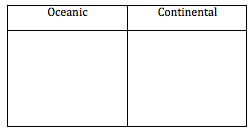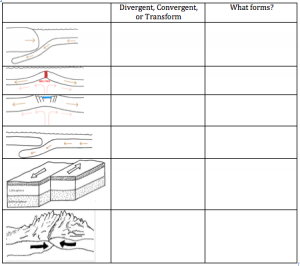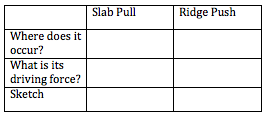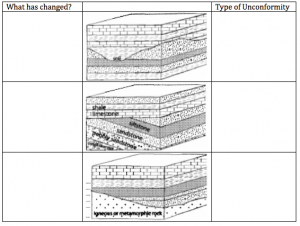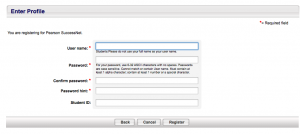March 3 Mon
- No opener Computer lab
March 4 Tues
1. Complete the table comparing oceanic and continental plates
2. What are the three types of plate boundaries?
- –> <– = ____________________ means coming together
- <– –> = ____________________ means moving apart
- <==> = ____________________ means moving past each other
March 5 Wednesday
Complete the diagram and check the answers to your poster.
1. Convergent Boundary animations
http://geology.com/nsta/convergent-plate-boundaries.shtml
2. Divergent Boundary animations
http://geology.com/nsta/divergent-plate-boundaries.shtml
3. Transform Boundaries
http://geology.com/nsta/transform-plate-boundaries.shtml
Be able to explain how diverging continental plates can eventually form an ocean.
Triangle of Afar
http://survinat.com/2012/09/in-africa-born-ocean-afar-triangle-photo/
Birth of an Ocean
http://www.scientificamerican.com/slideshow/birth-of-an-ocean-how-it-works/
March 6 Thursday
Volcanic hot spots
Google link to Hawaii
https://www.google.com/maps/@20.6762684,-156.4245792,684098m/data=!3m1!1e3
Google link to Craters of the moon + Yellowstone NP
- Use the second diagram on the website to explain mantle convection. http://csmres.jmu.edu/geollab/fichter/PlateTect/synopsis.html
- Explain the processes of slab pull and ridge push
How the Earth was Made: The Ring of Fire 43:47
https://www.youtube.com/watch?v=Xs4yNL1M8Gg&feature=relmfu
How the Earth was made: Iceland
https://www.youtube.com/watch?v=IhRK-RUGwbE&feature=related
National Geographic: Colliding Continents
https://www.youtube.com/watch?v=KCSJNBMOjJs&feature=related
March 7 Friday
- Ch 9.3/9.4 Quiz
- Last day of the quarter
——————————————————————————————-
Feb 24 Mon
No opener computer lab
Feb 25 Tues
Feb 26 Wed
Alfred Wegener Song
Pangea animation
Feb 27 Thurs
Plate tectonics Review
https://www.youtube.com/watch?v=JmC-vjQGSNM
Feb 28 Fri
————————————————————————————————–
Feb 17 Mon
No opener computer lab
Feb 18 Tues
1. Describe how Earth formed
______________ pulled dust, ice, and rocks together. Heat was produced by _________ and __________ decay.
As the Earth cooled, the Earth formed layers due to differences in ____________. This formed the ___________, ___________, and ____________
2. Describe how the atmosphere formed
Earth’s early atmosphere was similar to volcanic gases containing ______________, ___________, and nitrogen.
Later, life forms converted much of the carbon dioxide into __________ through photosynthesis.
3. Describe how the ocean formed
Later, as Earth cooled ________________ condensed to form the oceans.
Feb 19 Wed
Feb 20 Thurs
Feb 21 Fri
—————————————————————————————————————
Feb 10 Mon
- No opener- computer lab
Feb 11 Tues
- No opener DVD
Feb 12 Wed
- How old is the Earth?
- List the 4 units of geologic time in order from the longest to the shortest. (epoch, era, eon, period)
_________–> ____________–> ___________–> ___________
Complete the analogy:
- year = ____________
- month = ____________
- week = ____________
- day = _____________
Feb 13 Thurs
Fill in the blanks.
cenozoic mesozoic paleozoic
- __________ means ancient life
- __________ means middle life
- __________ means recent life
Feb 14 Fri
No opener quiz
———————————————————————————
Feb 3 Mon
No opener- computer lab
Feb 4 Tues
- What is radioactivity?
- What is a half-life?
Examine the graph.
- 3. What happens to the amount of carbon?
- 4. What happens to the amount of nitrogen?
- 5. What is the half-life of carbon?
6. You want to find the age of a fossil. Which material would you use for radiometric dating?
- carbon-14
- uranium-235
- either- it does not matter
7. Can you carbon date a living tree? Explain.
8. Can you carbon date a recent (less than 1,000 year old) object? Explain.
9. At what time does radio carbon dating stop working? Explain.
Feb 5 Wed
Examine the chart.
- What items could be dated with uranium? Explain.
- Why are you able to date the skull in layer B, but unable to date the skull in layer D?
- Describe a plan to date the skull in layer D.
Feb 6 Thurs
Feb 7 Fri
No opener. Quiz ch 12.3
—————————————————————————-
Jan 27 Monday
- No Opener- computer lab
- Hand back quizzes
- Hand out grade sheets. Get signed this week
Jan 28 Tues
What 2 conditions favor fossilization?
- ______________ burial
- _________ body parts
Studying fossils allows scientists to
- Improve the _____________ of rock layers
- ____________ past environments
What are the five types of fossils are how do they form?
Power Point Review identifying the types of fossils
Jan 29 Wed
- What is the mechanism by which evolution occurs?
- __________________ is the principle stating that fossils succeed each other in a definite and determinable order
- This idea states that life forms have changed forms or evolved over time from simple to more complex forms.
Jan 30 Thurs
- Computer lab
- Know the 5 characteristics of index fossils
Jan 31 Fri
- No opener Quiz ch 12.2
- A Bill Nye video to review fossils
- http://www.youtube.com/watch?v=AQeyieeRlZU
———————————————————————————–
Jan 20 Mon
- No school
Jan 21 Tues
- What is Relative Dating?
- What is Uniformitarianism? p. 337
- Define each and be able to apply to an example pp. 337-339
- Law of Superposition
- Principle of original horizontality
- Principle of cross-cutting relationships
Jan 22 Wed
Examine each sketch and determine the order of events.
To save time, I printed the sketches for today’s opener.
Rules of stratigraphy
http://www.dinojim.com/Geology/GeoBasics/stratigraphy.html
Practice relative dating with an interactive site
http://facweb.northseattle.edu/tbraziunas/geol101tb_partial/labs/reldatelab.html
http://hrsbstaff.ednet.ns.ca/butlers/relative%20dating%20review.htm
Jan 23 Thurs
Lab: Relative dating?
Correlation “matching” rock layers of the same age in different locations
Inclusions Pieces of one rock group that are contained in another rock group. The rock containing the inclusion is _____________ that the inclusion.
Index fossil A fossil associated with a specific period of geologic time
- Unique looking
- Lived a short period of time
- Found over a geographically large area
- Abundant in population
Strata a layer of sedimentary rock
Jan 24 Fri
No opener- Quiz Unit 2 week 1
——————————————————————————————————————
Jan 13 Monday
Complete the chart indicating processes that remove carbon from the atmosphere and which processes add carbon to the atmosphere.
Processes:
respiration dissolve into sea water photosynthesis
decay consumption (eating) combustion (burning)
Jan 14 Tues
No opener- computer lab
Jan 15 Wed
- What is an open system?
- What is a closed system?
- What type of system is a boiling tea kettle? Why?
- What type of system is the cooling system of a car? Why?
Identify the renewable resources
coal corn the sun aluminum bamboo
Examine the graph. Why has the rate of mineral and energy resource usage increased more rapidly than the population?
Jan 16 Thurs
No opener Quiz Unit 1 week 2
Jan 17 Friday
What is an unconformity?Describe the three types of unconformities?
—————————————————————————————————–
Jan 6 Monday
- Snow day
Jan 7 Tuesday
You have 3 objectives today:
- Sign up for on-line textbook
- Sign up for QuizStar on-line practice quizzes
- Take a tour of my website and resources available for you.
1. Register for on-line textbook
First period class access code:
ask for access code
Fourth period class access code:
ask for access code
User name = first two initials and student ID number
Password = LPS password
2. Register for QuizStar
Google “Quiz Star”
Click Student Login page
User name: first two initials + lps password
Password : LPS password
Jan 8 Wednesday
- What is the cell phone policy at East High School?
- What happens if homework is not turned in at the beginning of class?
- How can you earn bonus points on quizzes?
- What is your text book number?
Jan 9 Thursday
1. What are the 4 branches of geoscience?
2. Match the example to its “sphere”
atmosphere biosphere cryosphere geosphere hydrosphere
a. A meadow
b. The Indian Ocean
c. Mount Kilimanjaro
d. An iceberg
e. The air we breathe
3. What heats the Earth’s interior?
4. How do oceanic crust and continental crust differ?
3. Types of technology review power point
Jan 10 Friday
No opener Quiz Unit 1 week 1

